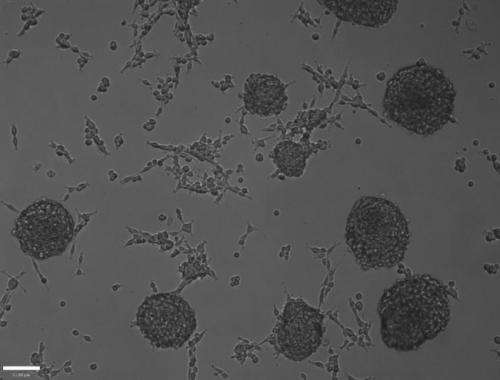September 25, 2015 report
Rigidity transition and cell migration in biological tissues

(Phys.org)—Cell migration is an intrinsic feature of multicellular organisms, enabling such processes as embryo development, wound healing, and immune responses. These activities require cells to move freely within tissues. Eukaryotic organisms develop from densely layered tissue types, and the dynamics of cell migration within and between tissues are explored both biomechanically and as complex physics problems, not only to understand proper cell function, but also to illuminate the consequences when cell migration goes wrong, resulting in various diseases, disabilities, and the development of tumors.
One such problem, now addressed in an article published in Nature Physics, deals with liquid-to-solid transitions in confluent tissues that have constant density and in which there are no gaps between cells. The authors, researchers at Syracuse University, propose a new type of rigidity transition that occurs in this condition.
Non-living disordered systems like those of granular matter are described by a so-called "jamming" transition, or rigidity transition, from a fluid-like state to a solid-like state that occurs as the density approaches a critical point. It's referred to as a rigidity transition because its density confers stability that begins to support shear stresses. Even absent the underlying math, this principle is intuitive. And recent studies have suggested that when living cells are densely packed, they exhibit similar behavior.
The authors note that many of the same features are found in self-propelled particle (SPP) models, which describe autonomous agents that convert energy from their surroundings into directed motion. Such particles change direction as they interact with their neighbors. The researchers asked if the density-driven rigidity transition in SPP models could explain the collective behavior of cells in non-proliferating congruent biological tissues.
By simulating confluent tissue monolayers, the researchers produced a point pattern that was then used as an input to Surface Evolver, a program that models liquid surfaces and the influences of various forces and constraints. They report a new type of rigidity transition that is not controlled by density, but rather a dimensionless target shape index specified by single-cell properties like cell-cell adhesion and cortical tension.
The authors write, "We expect that this rigidity framework will help experimentalists develop other testable hypotheses about how the mechanical response of tissues depends on single-cell responses. For example, Sadati et al. have proposed a jamming phase diagram where tissues become more solid-like as adhesion increases, based on observations of jamming in adhesive particulate matter at densities far below confluency... these ideas suggest that the role of adhesion in tissue rheology may be richer and more interesting than previously thought."
The authors suggest that their work could apply to cell migration dynamics of some types of tumorigenesis, in which epithelial cells with well-defined shapes transition to mesenchymal cells with irregular shapes and large perimeters relative to their areas. It may also provide a useful model for thermodynamic explanations of similar transitions in particulate matter, and for designing metamaterials with novel optical properties.
More information: "A density-independent rigidity transition in biological tissues." Nature Physics (2015) DOI: 10.1038/nphys3471
Abstract
Cell migration is important in many biological processes, including embryonic development, cancer metastasis and wound healing. In these tissues, a cell's motion is often strongly constrained by its neighbours, leading to glassy dynamics. Although self-propelled particle models exhibit a density-driven glass transition, this does not explain liquid-to-solid transitions in confluent tissues, where there are no gaps between cells and therefore the density is constant. Here we demonstrate the existence of a new type of rigidity transition that occurs in the well-studied vertex model for confluent tissue monolayers at constant density. We find that the onset of rigidity is governed by a model parameter that encodes single-cell properties such as cell–cell adhesion and cortical tension, providing an explanation for liquid-to-solid transitions in confluent tissues and making testable predictions about how these transitions differ from those in particulate matter.
Journal information: Nature Physics
© 2015 Phys.org




















